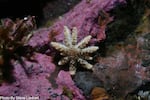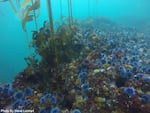
Baby sunflower sea star off the coast of Carmel, Calif., in 2014.
Steve Lonhart / Steve Lonhart
One of the largest sea star species in the world has been listed as critically endangered on Thursday after a global study shows the species population has been decimated by a marine epidemic.
The sunflower sea star, once abundant in marine waters from Alaska to Baja California in Mexico, is on the brink of extinction along the West Coast waters in the United States after a marine wildlife epidemic event referred to as the sea star wasting syndrome began in 2013. The wasting syndrome, which essentially melts away the sea star, is the result of a pathogen that affected many different species but affected the sunflower sea star the most.
Related: Sea star wasting syndrome arrives in Oregon
Also, an increase in ocean temperatures during 2014-2016 that resulted in a phenomenon known as “the blob” played a role in the species’ declining population and have been struggling to recover ever since. This led to an increase in sea urchins along the West Coast and a decrease in kelp.
Oregon State University, along with The Nature Conservancy and dozens of conservation groups, led a groundbreaking study that found 90.6% of the species population has been wiped out and estimated as many as 5.75 billion animals died from the disease since the die-off began. This has led the International Union for Conservation of Nature (IUCN) to list the sunflower sea star (Pycnopodia helianthoides) as critically endangered.
The study used more than 61,000 surveys from 31 datasets and showed no signs of the population’s recovery in any region it is known to be located since the outbreak began.
Walter Heady is a scientist with the Nature Conservancy. He said having international recognition through the IUCN of the dramatic loss of this species will allow for the appropriate research and conservation actions needed to aid its recovery.
“IUCN really provides a foundation for that conservation effort for sunflower sea stars,” he said. “It provides a foundation of scientific knowledge to inform data gaps, as well as potential conservation pathways to really provide the foundation and provide motivation and direction for current and future scientific research and conservation efforts.”
The IUCN Red List of Threatened Species lists species in one of eight categories of threat based on certain criteria like population trend, size, and range.
Heady said the dramatic die-off of this species in its known geographic range is related to the changing conditions due to climate change.
“What that means is this important marine species and this important predator is missing from the many ecosystems in which it is found,” Heady said. “What that means for California and Oregon is, we’ve also observed some dramatic losses of our kelps in the past few years as well.”

A barren kelp forest off the coast of Carmel, Calif with hundreds of sea urchin.
Steve Lonhart / Steve Lonhart
Sunflower sea stars play a vital role in helping to maintain kelp forests, which in return supply habitats for marine life and also help in sequestering carbon. The declining population for the sunflower sea star and vulnerability of kelp forests have caused a significant increase of purple urchins along the West Coast.
OSU Research Associate and lead analysis author Sarah Gravem said the past few years is what she calls a perfect storm of ecosystem destruction that first started off with the sea star wasting in 2013. Then a year later the marine heatwave came through and the increase of sea urchins.
“Between the sea stars being gone, the urchins increasing and having lots of babies, and the kelp being killed, that’s left the situation where we have just urchins everywhere,” she said.
Related: Some sea stars are experiencing a West Coast baby boom
Gravem said now that the species has been listed as critically endangered, it gives researchers and conservation groups an opportunity to develop a roadmap to begin to recover the species.
Some ideas to help the species recover include relocating the sunflower sea star, collecting sea urchins off the reef and relocating them, or replanting kelp along the West Coast to help them restore.
Another idea that would be a first of its kind for the species would be a captive rearing effort.
“This effort really highlights the importance of science to inform conservation and sound management decisions,” he said.
